Effect of Soil Texture on Water and Salt Transport in Freeze—Thaw Soil in the Shallow Groundwater Area
Abstract
:1. Introduction
2. Materials and Methods
2.1. Experimental Conditions
2.2. Experimental Methods
2.3. Grey Relation Analysis
2.4. Pearson Correlation Analysis
3. Results
3.1. Freeze–Thaw Processes of Different Textured Soils
3.2. Characteristics of Water Transport in Different Textured Soils
3.3. Characteristics of Ion Content Variation in Different Textured Soils
3.3.1. Correlation Analysis between Soil Salt Content and Ions
3.3.2. Characteristics of Ca2+ Content Variation
3.3.3. Characteristics of Na+ Content Variation
3.3.4. Characteristics of Cl− Content Variation
3.3.5. Characteristics of SO42− Content Variation
3.3.6. Characteristics of HCO3− Content Variation
3.4. Characteristics of Soil Salt Content Variation
4. Discussion
4.1. Correlation Analysis between Soil Water and Salt
4.2. Effect of Freeze–Thaw Process on Water and Salt Transport in Different Textured Soils
5. Conclusions
Author Contributions
Funding
Data Availability Statement
Acknowledgments
Conflicts of Interest
References
- Chen, S.; Ouyang, W.; Hao, F.; Zhao, X. Combined impacts of freeze-thaw processes on paddy land and dry land in Northeast China. Sci. Total Environ. 2013, 456–457, 24–33. [Google Scholar] [CrossRef] [PubMed]
- Ireson, A.M.; van der Kamp, G.; Ferguson, G.; Nachshon, U.; Wheater, H.S. Hydrogeological processes in seasonally frozen northern latitudes: Understanding, gaps and challenges. Hydrogeol. J. 2012, 21, 53–66. [Google Scholar] [CrossRef]
- Bechtold, M.; Haber-Pohlmeier, S.; Vanderborght, J.; Pohlmeier, A.; Ferré, T.P.A.; Vereecken, H. Near-surface solute redistribution during evaporation. Geophys. Res. Lett. 2011, 38, L17404. [Google Scholar] [CrossRef] [Green Version]
- Li, Z.; Wang, Z. Experimental study on the relation between the fractal characteristics and solute transport parameters of sandy soil. J. Soils Sediments 2020, 20, 3181–3191. [Google Scholar] [CrossRef]
- Bing, H.; He, P.; Zhang, Y. Cyclic freeze–thaw as a mechanism for water and salt migration in soil. Environ. Earth Sci. 2015, 74, 675–681. [Google Scholar] [CrossRef] [Green Version]
- Han, Y.; Wang, Q.; Xia, W.; Liu, J.; Wang, J.; Chen, Y.; Shen, J. Experimental study on the hydraulic conductivity of unsaturated dispersive soil with different salinities subjected to freeze-thaw. J. Hydrol. 2020, 583, 124297. [Google Scholar] [CrossRef]
- Yang, J.; Zhao, J.; Zhu, G.; Wen, Y.; Wang, Y.; Liu, J.; Yang, Z. Effects of Ecological Water Conveyance on Soil Salinization in the Shiyang River Basin’s Terminal Lake—Qingtu Lake—Area. Sustainability 2022, 14, 311. [Google Scholar] [CrossRef]
- Ma, Y.; Tashpolat, N. Current Status and Development Trend of Soil Salinity Monitoring Research in China. Sustainability 2023, 15, 5874. [Google Scholar] [CrossRef]
- Mirbakhsh, M.; Sedeh, S.S. Effect of short and long period of salinity stress on physiological responses and biochemical markers of Aloe vera L. Purdue Univ. Alzahra Univ. 2022, 7, 178–187. [Google Scholar] [CrossRef]
- Wu, M.; Huang, J.; Tan, X.; Wu, J. Water, Salt and Heat Influences on Carbon and Nitrogen Dynamics in Seasonally Frozen Soils in Hetao Irrigation District, Inner Mongolia, China. Pedosphere 2019, 29, 632–641. [Google Scholar] [CrossRef]
- Wu, D.; Zhou, X.; Jiang, X. Water and Salt Migration with Phase Change in Saline Soil during Freezing and Thawing Processes. Ground Water 2018, 56, 742–752. [Google Scholar] [CrossRef] [PubMed]
- Wan, H.; Bian, J.; Zhang, H.; Li, Y. Assessment of future climate change impacts on water-heat-salt migration in unsaturated frozen soil using CoupModel. Front. Environ. Sci. Eng. 2020, 15, 10. [Google Scholar] [CrossRef]
- Lu, X.; Li, R.; Shi, H.; Liang, J.; Miao, Q.; Fan, L. Successive simulations of soil water-heat-salt transport in one whole year of agriculture after different mulching treatments and autumn irrigation. Geoderma 2019, 344, 99–107. [Google Scholar] [CrossRef]
- Xun, Y.; Xiao, X.; Sun, C.; Meng, H.; Gao, Y.; Huang, G.; Xu, X. Modeling heat-water-salt transport, crop growth and water use in arid seasonally frozen regions with an improved coupled SPAC model. J. Hydrol. 2022, 615, 128703. [Google Scholar] [CrossRef]
- Hou, R.; Qi, Z.; Li, T.; Fu, Q.; Meng, F.; Liu, D.; Li, Q.; Zhao, H.; Yu, P. Mechanism of snowmelt infiltration coupled with salt transport in soil amended with carbon-based materials in seasonally frozen areas. Geoderma 2022, 420, 115882. [Google Scholar] [CrossRef]
- Tan, X.; Wu, J.; Wu, M.; Huang, J.; Tan, B.; Li, L. Effects of ice cover on soil water, heat, and solute movement: An experimental study. Geoderma 2021, 403, 115209. [Google Scholar] [CrossRef]
- You, Z.; Wen, W.; Lai, Y.; Zhang, M.; Zhang, J. Model tests of the barrier measures on moisture and salt migration in soils subjected to freeze-thaw cycles. Cold Reg. Sci. Technol. 2022, 201, 103607. [Google Scholar] [CrossRef]
- Liu, S.; Huang, Q.; Zhang, W.; Ren, D.; Xu, X.; Xiong, Y.; Huang, G. An improved estimation of soil water and salt dynamics by considering soil bulk density changes under freeze/thaw conditions in arid areas with shallow groundwater tables. Sci. Total Environ. 2023, 859, 160342. [Google Scholar] [CrossRef]
- Li, L.; Liu, H.; Gong, P.; Lin, E.; Bai, Z.; Li, P.; Wang, C.; Li, J. Multi-objective optimization of winter irrigation for cotton fields in salinized freeze-thaw areas. Eur. J. Agron. 2023, 143, 126715. [Google Scholar] [CrossRef]
- Wan, X.; Gong, F.; Qu, M.; Qiu, E.; Zhong, C. Experimental Study of the Salt Transfer in a Cold Sodium Sulfate Soil. KSCE J. Civ. Eng. 2019, 23, 1573–1585. [Google Scholar] [CrossRef]
- Huang, X.; Zhang, Z.; Hao, R.; Guo, Z. The Effects of Particle Gradation on Salinized Soil in Arid and Cold Regions. Water 2022, 14, 236. [Google Scholar] [CrossRef]
- Hou, R.-j.; Li, T.-x.; Fu, Q.; Liu, D.; Li, M.; Zhou, Z.-q.; Yan, J.-w.; Zhang, S. Research on the distribution of soil water, heat, salt and their response mechanisms under freezing conditions. Soil Tillage Res. 2020, 196, 104486. [Google Scholar] [CrossRef]
- Mohawesh, O.; Janssen, M.; Maaitah, O.; Lennartz, B. Assessment the effect of homogenized soil on soil hydraulic properties and soil water transport. Eurasian Soil Sci. 2017, 50, 1077–1085. [Google Scholar] [CrossRef]
- Zhang, N.; Yu, X.; Pradhan, A.; Puppala, A.J. Effects of Particle Size and Fines Content on Thermal Conductivity of Quartz Sands. Transp. Res. Rec. 2015, 2510, 36–43. [Google Scholar] [CrossRef]
- Li, X.; Guo, M.; Wang, H. Impact of soil texture and salt type on salt precipitation and evaporation under different hydraulic conditions. Hydrol. Process. 2022, 36, e14763. [Google Scholar] [CrossRef]
- Li, X.; Chang, S.X.; Salifu, K.F. Soil texture and layering effects on water and salt dynamics in the presence of a water table: A review. Environ. Rev. 2014, 22, 41–50. [Google Scholar] [CrossRef]
- Wang, J.-j.; Huang, Y.-f.; Long, H.-y. Water and salt movement in different soil textures under various negative irrigating pressures. J. Integr. Agric. 2016, 15, 1874–1882. [Google Scholar] [CrossRef] [Green Version]
- Wang, J.; Huang, Y.; Long, H.; Hou, S.; Xing, A.; Sun, Z. Simulations of water movement and solute transport through different soil texture configurations under negative-pressure irrigation. Hydrol. Process. 2017, 31, 2599–2612. [Google Scholar] [CrossRef]
- Panta, S.; Flowers, T.; Doyle, R.; Lane, P.; Haros, G.; Shabala, S. Growth responses of Atriplex lentiformis and Medicago arborea in three soil types treated with saline water irrigation. Environ. Exp. Bot. 2016, 128, 39–50. [Google Scholar] [CrossRef]
- Liu, D.; She, D.; Mu, X. Water flow and salt transport in bare saline-sodic soils subjected to evaporation and intermittent irrigation with saline/distilled water. Land Degrad. Dev. 2019, 30, 1204–1218. [Google Scholar] [CrossRef]
- Liu, Q.; Liu, Y.; Jin, M.; He, J.; Ferré, P.A.T. Impacts of an Internal Finer-Textured Layer on Soil Evaporation and Salt Distribution. Transp. Porous Media 2021, 140, 603–620. [Google Scholar] [CrossRef]
- Xu, C.; Zeng, W.-Z.; Wu, J.-W.; Huang, J.-S. Effects of Different Irrigation Strategies on Soil Water, Salt, and Nitrate Nitrogen Transport. Ecol. Chem. Eng. S 2015, 22, 589–609. [Google Scholar] [CrossRef] [Green Version]
- Nachshon, U.; Weisbrod, N.; Dragila, M.I.; Grader, A. Combined evaporation and salt precipitation in homogeneous and heterogeneous porous media. Water Resour. Res. 2011, 47, W03513. [Google Scholar] [CrossRef]
- Chen, J.; Wang, E.; Xue, J.; Cui, L.; Zheng, X.; Du, Q. Effects of soil particle size and gradation on the transformation between shallow phreatic water and soil water under laboratory freezing-thawing action. J. Hydrol. 2023, 619, 129323. [Google Scholar] [CrossRef]
- Miao, C.; Chen, J.; Zheng, X.; Zhang, Y.; Xu, Y.; Du, Q. Soil Water and Phreatic Evaporation in Shallow Groundwater during a Freeze–Thaw Period. Water 2017, 9, 396. [Google Scholar] [CrossRef] [Green Version]
- Ambade, B.; Sethi, S.S.; Giri, B.; Biswas, J.K.; Bauddh, K. Characterization, Behavior, and Risk Assessment of Polycyclic Aromatic Hydrocarbons (PAHs) in the Estuary Sediments. Bull Environ. Contam. Toxicol. 2022, 108, 243–252. [Google Scholar] [CrossRef] [PubMed]
- Ambade, B.; Sethi, S.S.; Chintalacheruvu, M.R. Distribution, risk assessment, and source apportionment of polycyclic aromatic hydrocarbons (PAHs) using positive matrix factorization (PMF) in urban soils of East India. Environ. Geochem. Health 2023, 45, 491–505. [Google Scholar] [CrossRef]
- Kumar, A.; Ambade, B.; Sankar, T.K.; Sethi, S.S.; Kurwadkar, S. Source identification and health risk assessment of atmospheric PM2.5-bound polycyclic aromatic hydrocarbons in Jamshedpur, India. Sustain. Cities Soc. 2020, 52, 101801. [Google Scholar] [CrossRef]
- Ambade, B.; Sethi, S.S.; Kurwadkar, S.; Mishra, P.; Tripathee, L. Accumulation of polycyclic aromatic hydrocarbons (PAHs) in surface sediment residues of Mahanadi River Estuary: Abundance, source, and risk assessment. Mar. Pollut. Bull 2022, 183, 114073. [Google Scholar] [CrossRef]
- Sankar, T.K.; Kumar, A.; Mahto, D.K.; Das, K.C.; Narayan, P.; Fukate, M.; Awachat, P.; Padghan, D.; Mohammad, F.; Al-Lohedan, H.A.; et al. The Health Risk and Source Assessment of Polycyclic Aromatic Hydrocarbons (PAHs) in the Soil of Industrial Cities in India. Toxics 2023, 11, 515. [Google Scholar] [CrossRef]
- Ambade, B.; Rao, C.M. Assessment of groundwater quality with a special emphasis on fluoride contamination in Rajnandgaon district of Chhattisgarh state in central India. Int. J. Environ. Sci. 2012, 3, 851–858. [Google Scholar] [CrossRef]
- Li, S.; Lu, L.; Gao, Y.; Zhang, Y.; Shen, D. An Analysis on the Characteristics and Influence Factors of Soil Salinity in the Wasteland of the Kashgar River Basin. Sustainability 2022, 14, 3500. [Google Scholar] [CrossRef]
- Zhang, Z.; Abuduwaili, J.; Jiang, F. Relationship of Heavy Metals and Soil N, P, K and Total Salts in Tianshan Mountains, Central Asia. Asian J. Chem. 2013, 25, 8971–8975. [Google Scholar] [CrossRef]
- Chen, J.; Xie, X.; Zheng, X.; Xue, J.; Miao, C.; Du, Q.; Xu, Y. Effects of sand-mulch thickness on soil evaporation during the freeze–thaw period. Hydrol. Process. 2020, 34, 2830–2842. [Google Scholar] [CrossRef]
- Chen, J.; Gao, X.; Zheng, X.; Miao, C.; Liu, P.; Du, Q.; Xu, Y. Transformation between Phreatic Water and Soil Water during Freeze–Thaw Periods. Water 2018, 10, 376. [Google Scholar] [CrossRef] [Green Version]
- Li, Y.; Huo, S.; Guo, J.; Sun, J.; Pan, J.; Wang, D.; Tan, Q.; Pei, B. Using hydrogen and oxygen stable isotopes to estimate soil water evaporation loss under continuous evaporation conditions. Hydrol. Process. 2023, 37, e14885. [Google Scholar] [CrossRef]
- Wu, M.; Huang, J.; Wu, J.; Tan, X.; Jansson, P.-E. Experimental study on evaporation from seasonally frozen soils under various water, solute and groundwater conditions in Inner Mongolia, China. J. Hydrol. 2016, 535, 46–53. [Google Scholar] [CrossRef]
- Jamshidi, S.; Zand-Parsa, S.; Kamgar-Haghighi, A.A.; Shahsavar, A.R.; Niyogi, D. Evapotranspiration, crop coefficients, and physiological responses of citrus trees in semi-arid climatic conditions. Agric. Water Manag. 2020, 227, 105838. [Google Scholar] [CrossRef]
- Boini, A.; Manfrini, L.; Bortolotti, G.; Corelli-Grappadelli, L.; Morandi, B. Monitoring fruit daily growth indicates the onset of mild drought stress in apple. Sci. Hortic. 2019, 256, 108520. [Google Scholar] [CrossRef]
- Fathian, M.; Bazrafshan, O.; Jamshidi, S.; Jafari, L. Impacts of climate change on water footprint components of rainfed and irrigated wheat in a semi-arid environment. Environ. Monit. Assess. 2023, 195, 324. [Google Scholar] [CrossRef]
- Wan, W.; Liu, Z.; Li, K.; Wang, G.; Wu, H.; Wang, Q. Drought monitoring of the maize planting areas in Northeast and North China Plain. Agric. Water Manag. 2021, 245, 106636. [Google Scholar] [CrossRef]
- Xiao, L.; Yuan, G.D.; Feng, L.R.; Shah, G.M.; Wei, J. Biochar to Reduce Fertilizer Use and Soil Salinity for Crop Production in the Yellow River Delta. J. Soil Sci. Plant Nutr. 2022, 22, 1478–1489. [Google Scholar] [CrossRef]
- Stojšin, M.M.; Petrović, S.; Banjac, B.; Zečević, V.; Nikolić, S.R.; Majstorović, H.; Đorđević, R.; Knežević, D. Assessment of Genotype Stress Tolerance as an Effective Way to Sustain Wheat Production under Salinity Stress Conditions. Sustainability 2022, 14, 6973. [Google Scholar] [CrossRef]
- Lu, Y.; Liu, S.; Zhang, Y.; Wang, L.; Li, Z. Hydraulic conductivity of gravelly soils with various coarse particle contents subjected to freeze–thaw cycles. J. Hydrol. 2021, 598, 126302. [Google Scholar] [CrossRef]
- Ma, D.; He, Z.; Wang, L.; Zhao, W.; Chen, L.; Lin, P.; Zhao, P.; Wang, W.; Gao, Y.; Li, J. Soil water and salt migration in oasis farmland during crop growing season. J. Soils Sediments 2022, 23, 355–367. [Google Scholar] [CrossRef]
- Liu, J.; Yang, P.; Yang, Z. Water and salt migration mechanisms of saturated chloride clay during freeze-thaw in an open system. Cold Reg. Sci. Technol. 2021, 186, 103277. [Google Scholar] [CrossRef]
- Qin, Y.; Bai, Y.; Chen, G.; Liang, Y.; Li, X.; Wen, B.; Lu, X.; Li, X. The effects of soil freeze-thaw processes on water and salt migrations in the western Songnen Plain, China. Sci. Rep. 2021, 11, 3888. [Google Scholar] [CrossRef] [PubMed]
- Cao, Q.; Yang, B.; Li, J.; Wang, R.; Liu, T.; Xiao, H. Characteristics of soil water and salt associated with Tamarix ramosissima communities during normal and dry periods in a semi-arid saline environment. Catena 2020, 193, 104661. [Google Scholar] [CrossRef]
- Wang, M.; Zhu, Y.; Zhao, T.; Cui, L.; Mao, W.; Ye, M.; Wu, J.; Yang, J. Chemical characteristics of salt migration in frozen soils during the freezing-thawing period. J. Hydrol. 2022, 606, 127403. [Google Scholar] [CrossRef]
- Zhang, R.; Sun, Z.; Li, G.; Wang, H.; Cheng, J.; Hao, M. Influences of water chemical property on infiltration into mixed soil consisting of feldspathic sandstone and aeolian sandy soil. Sci. Rep. 2020, 10, 19497. [Google Scholar] [CrossRef]
- Zhang, S.X.; Zhang, Z.Y.; Jiang, S.W.; Yu, J. Effect of Different Management Systems on Soil Water Content in the Black Soil of Northeast China. Adv. Mater. Res. 2012, 610–613, 2912–2915. [Google Scholar] [CrossRef]
- Guo, K.; Liu, X. Effect of initial soil water content and bulk density on the infiltration and desalination of melting saline ice water in coastal saline soil. Eur. J. Soil Sci. 2019, 70, 1249–1266. [Google Scholar] [CrossRef]
- Wu, C.; Bi, Y.; Christie, P. Influence of Loess Interlayer Thickness on Water Transport in Sand. Pol. J. Environ. Stud. 2022, 31, 3317–3325. [Google Scholar] [CrossRef]
- Li, T.; Hao, X.; Kang, S. Spatiotemporal Variability of Soil Moisture as Affected by Soil Properties during Irrigation Cycles. Soil Sci. Soc. Am. J. 2014, 78, 598–608. [Google Scholar] [CrossRef] [Green Version]
- Chen, J.; Ren, J.; Wang, E.; Cui, L.; Xue, J.; Zheng, X.; Du, Q. Effect of the interlayer on soil temperature and the transformation between phreatic water and soil water under laboratory freeze-thaw action. Front. Earth Sci. 2023, 11, 677. [Google Scholar] [CrossRef]
- Wösten, J.H.M.; Pachepsky, Y.A.; Rawls, W.J. Pedotransfer functions: Bridging the gap between available basic soil data and missing soil hydraulic characteristics. J. Hydrol. 2001, 251, 123–150. [Google Scholar] [CrossRef]
- Zhang, N.; Yu, X.; Pradhan, A.; Puppala, A.J. A new generalized soil thermal conductivity model for sand–kaolin clay mixtures using thermo-time domain reflectometry probe test. Acta Geotech. 2016, 12, 739–752. [Google Scholar] [CrossRef]
- Libohova, Z.; Seybold, C.; Wysocki, D.; Wills, S.; Schoeneberger, P.; Williams, C.; Lindbo, D.; Stott, D.; Owens, P.R. Reevaluating the effects of soil organic matter and other properties on available water-holding capacity using the National Cooperative Soil Survey Characterization Database. J. Soil Water Conserv. 2018, 73, 411–421. [Google Scholar] [CrossRef] [Green Version]
- Zhao, Y.; Si, B.; Zhang, Z.; Li, M.; He, H.; Hill, R.L. A new thermal conductivity model for sandy and peat soils. Agric. For. Meteorol. 2019, 274, 95–105. [Google Scholar] [CrossRef]
- Tan, S.B.K.; Shuy, E.B.; Chua, L.H.C.; Mzila, N. Estimation of areal specific yield in sands using the central limit theorem. Hydrol. Process. 2006, 20, 3975–3987. [Google Scholar] [CrossRef]
- Shen, J.-H.; Hu, M.-J.; Wang, X.; Zhang, C.-Y.; Xu, D.-S. SWCC of Calcareous Silty Sand Under Different Fines Contents and dry Densities. Front. Environ. Sci. 2021, 9, 682907. [Google Scholar] [CrossRef]
- Zhang, X.; Shu, C.; Wu, Y.; Ye, P.; Du, D. Advances of coupled water-heat-salt theory and test techniques for soils in cold and arid regions: A review. Geoderma 2023, 432, 116378. [Google Scholar] [CrossRef]
- Hao, G.; Zhang, Z.; Guan, C.; Liu, G.; Hao, Y.; Fu, T. Influence of Soil Salinization on Active Layer Thickness of Frozen Soil. Atmosphere 2023, 14, 296. [Google Scholar] [CrossRef]
- Zhang, X.; Wang, Q.; Wang, G.; Wang, W.; Chen, H.; Zhang, Z. A Study on the Coupled Model of Hydrothermal-Salt for Saturated Freezing Salinized Soil. Math. Probl. Eng. 2017, 2017, 4918461. [Google Scholar] [CrossRef] [Green Version]
- Yang, C.; Wu, J.; Li, P.; Wang, Y.; Yang, N. Evaluation of Soil-Water Characteristic Curves for Different Textural Soils Using Fractal Analysis. Water 2023, 15, 772. [Google Scholar] [CrossRef]
- Chen, S.; Mao, X.; Shukla, M.K. Evaluating the effects of layered soils on water flow, solute transport, and crop growth with a coupled agro-eco-hydrological model. J. Soils Sediments 2020, 20, 3442–3458. [Google Scholar] [CrossRef]
- Liu, B.; Wang, S.; Kong, X.; Liu, X. Soil matric potential and salt transport in response to different irrigated lands and soil heterogeneity in the North China Plain. J. Soils Sediments 2019, 19, 3982–3993. [Google Scholar] [CrossRef]
- Liu, S.; Huang, Q.; Zhang, W.; Ren, D.; Huang, G. Improving soil hydrological simulation under freeze–thaw conditions by considering soil deformation and its impact on soil hydrothermal properties. J. Hydrol. 2023, 619, 129336. [Google Scholar] [CrossRef]
- Jia, J.; Zhang, P.; Yang, X.; Zhang, X.; Lupwayi, N. Feldspathic sandstone addition and its impact on hydraulic properties of sandy soil. Can. J. Soil Sci. 2018, 98, 399–406. [Google Scholar] [CrossRef]
- El-Hefnawy, M.E.; Selim, E.M.; Assaad, F.F.; Ismail, A.I. The effect of chloride and sulfate ions on the adsorption of Cd2+ on clay and sandy loam Egyptian soils. Sci. World J. 2014, 2014, 806252. [Google Scholar] [CrossRef] [Green Version]
- Pei, Y.; Huang, L.; Li, D.; Shao, M.A. Characteristics and controls of solute transport under different conditions of soil texture and vegetation type in the water-wind erosion crisscross region of China’s Loess Plateau. Chemosphere 2021, 273, 129651. [Google Scholar] [CrossRef] [PubMed]
- Luo, J.M.; Yang, F.; Wang, Y.J.; Ya, Y.J.; Deng, W.; Zhang, X.P.; Liu, Z. Mechanism of Soil Sodification at the Local Scale in Songnen Plain, Northeast China, as Affected by Shallow Groundwater Table. Arid. Land Res. Manag. 2011, 25, 234–256. [Google Scholar] [CrossRef]
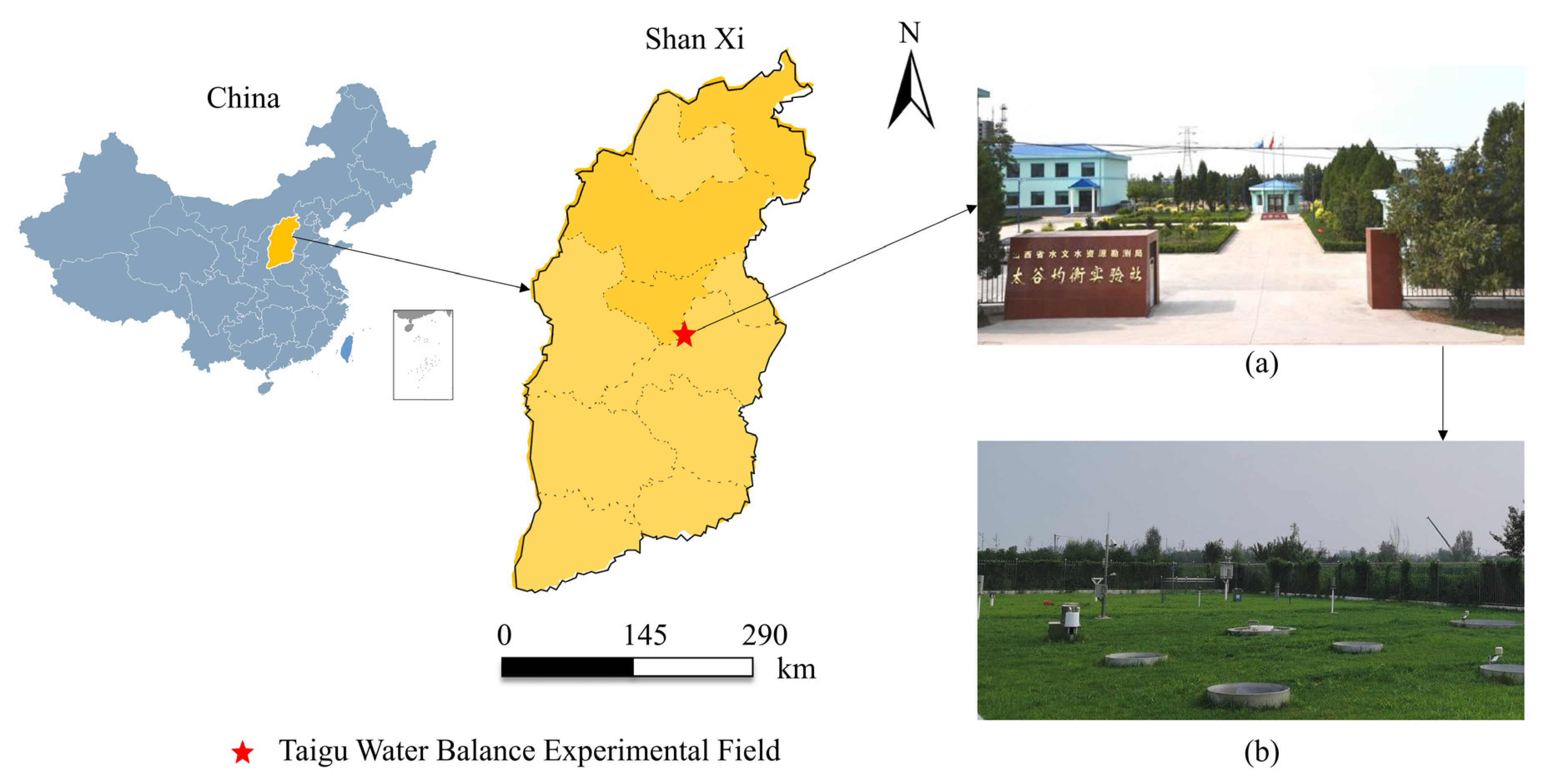
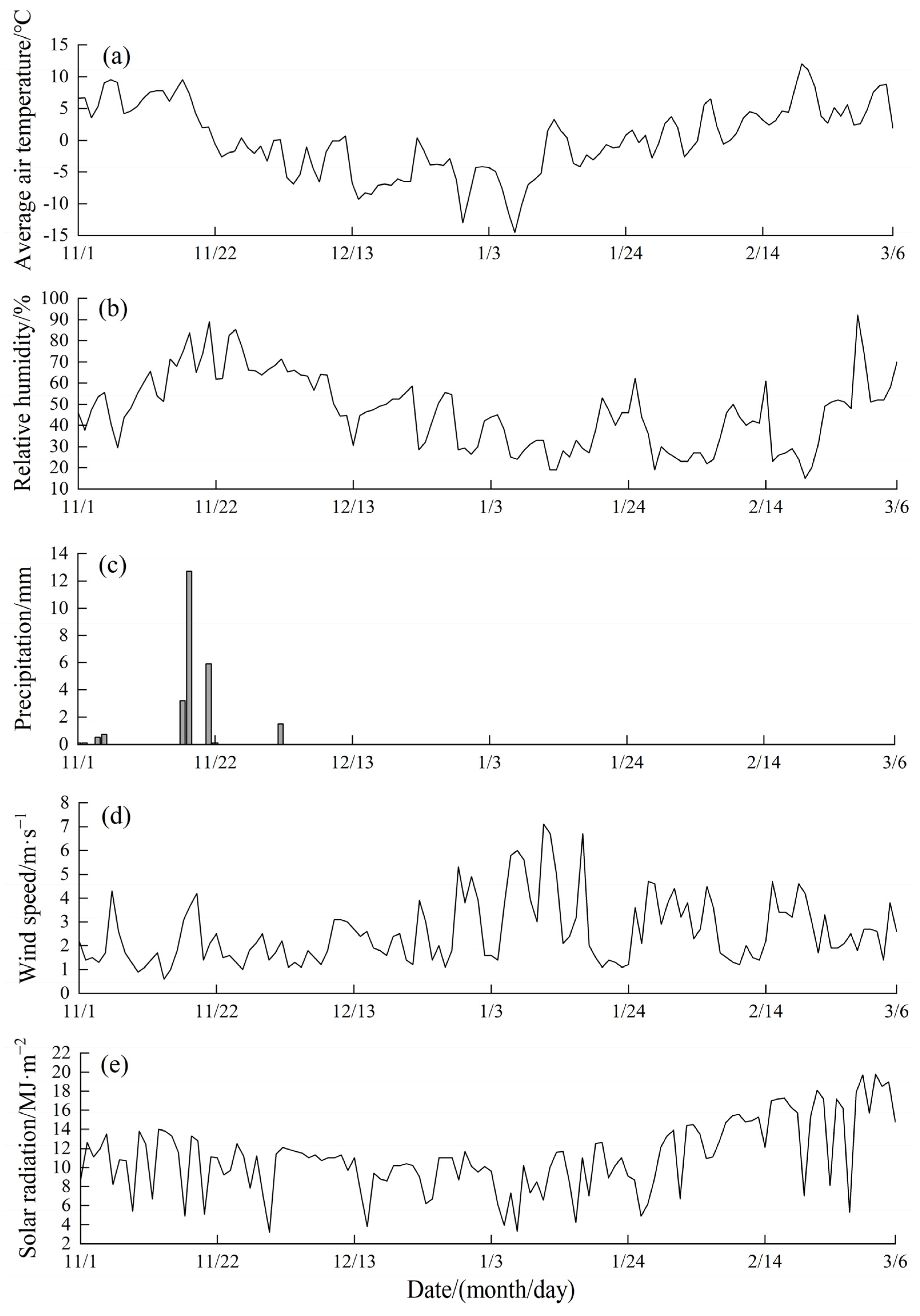
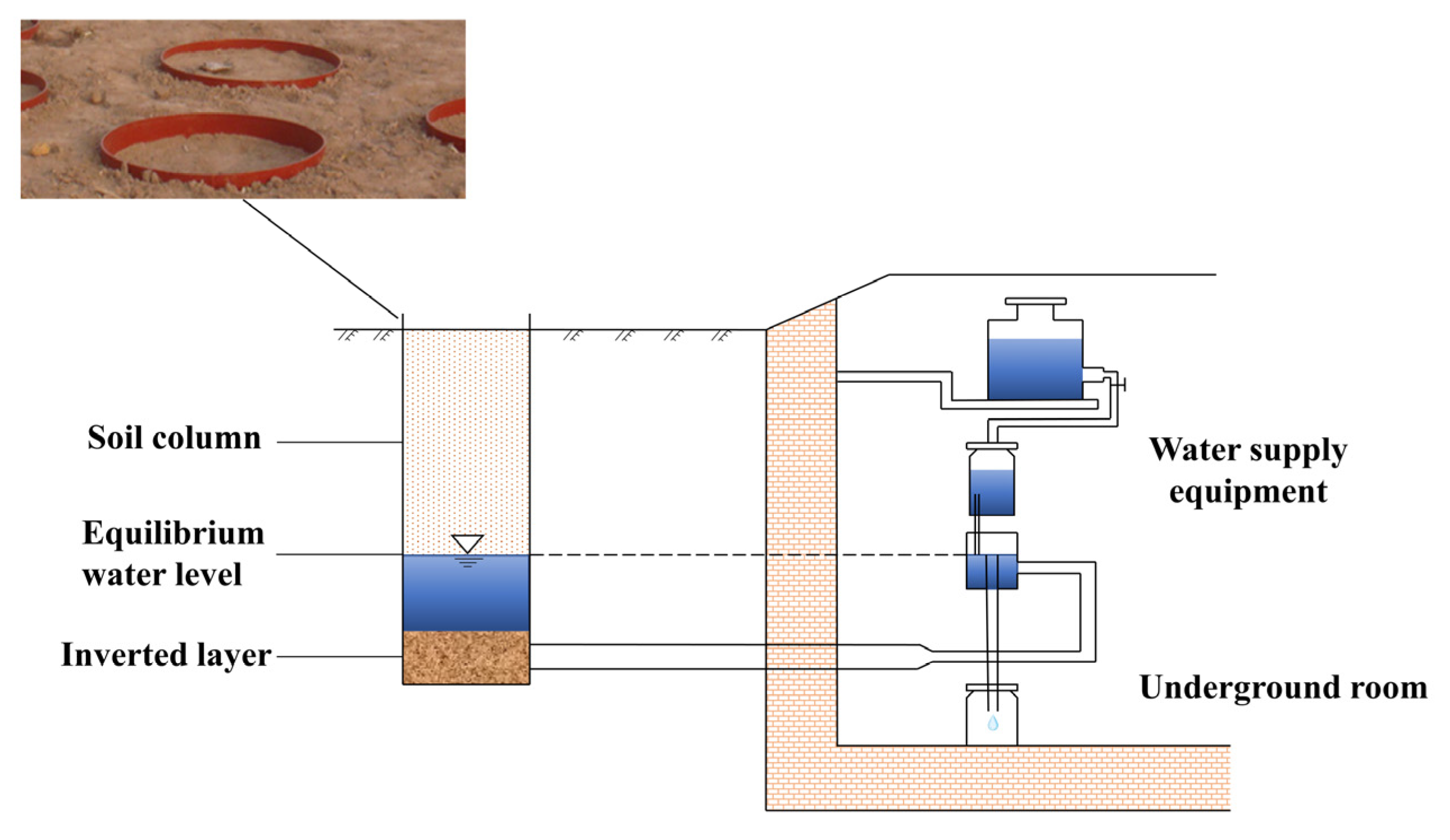


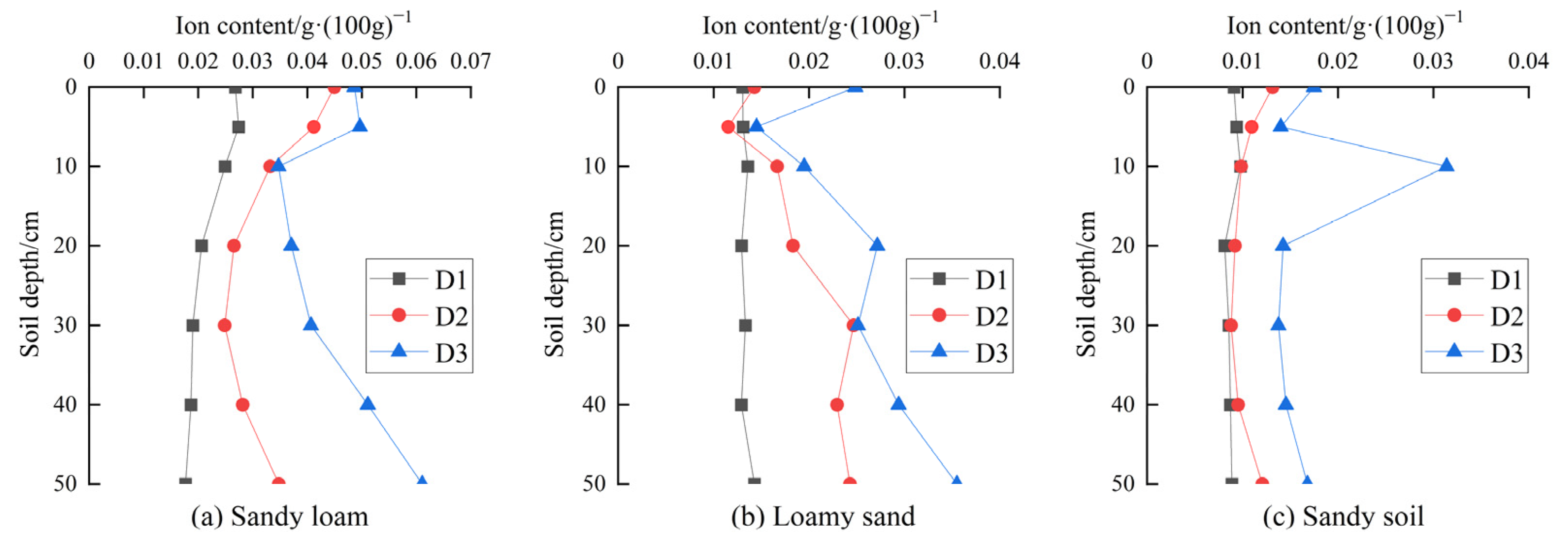
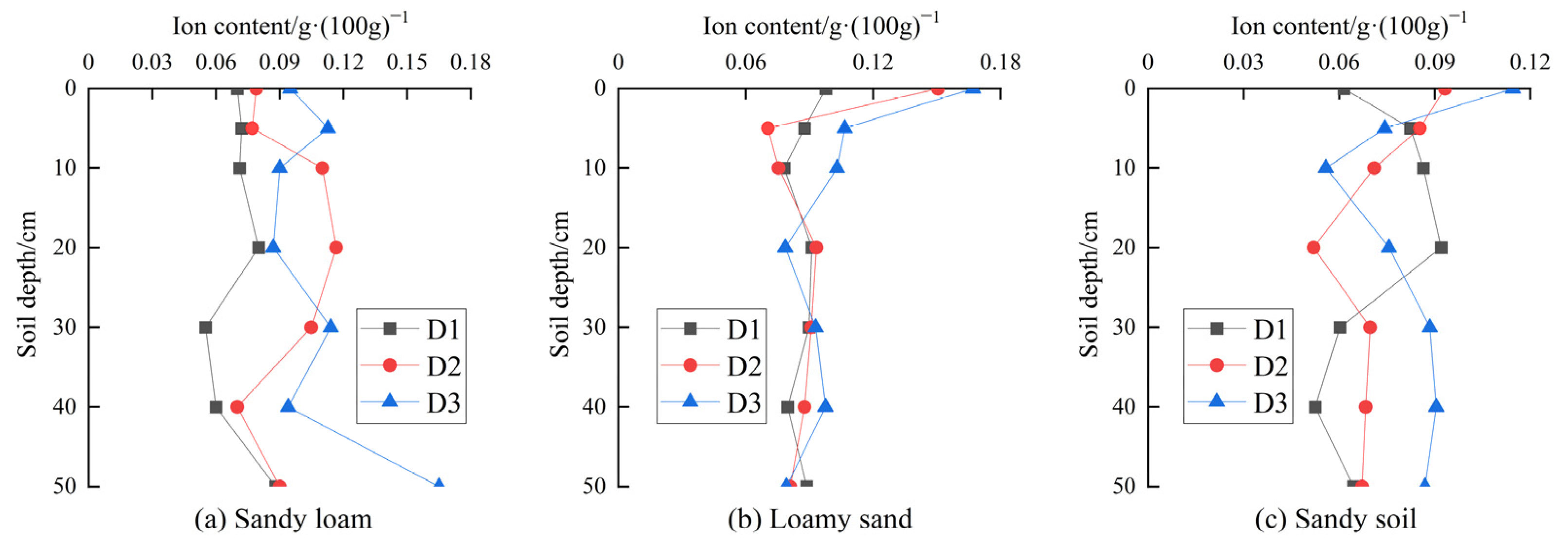
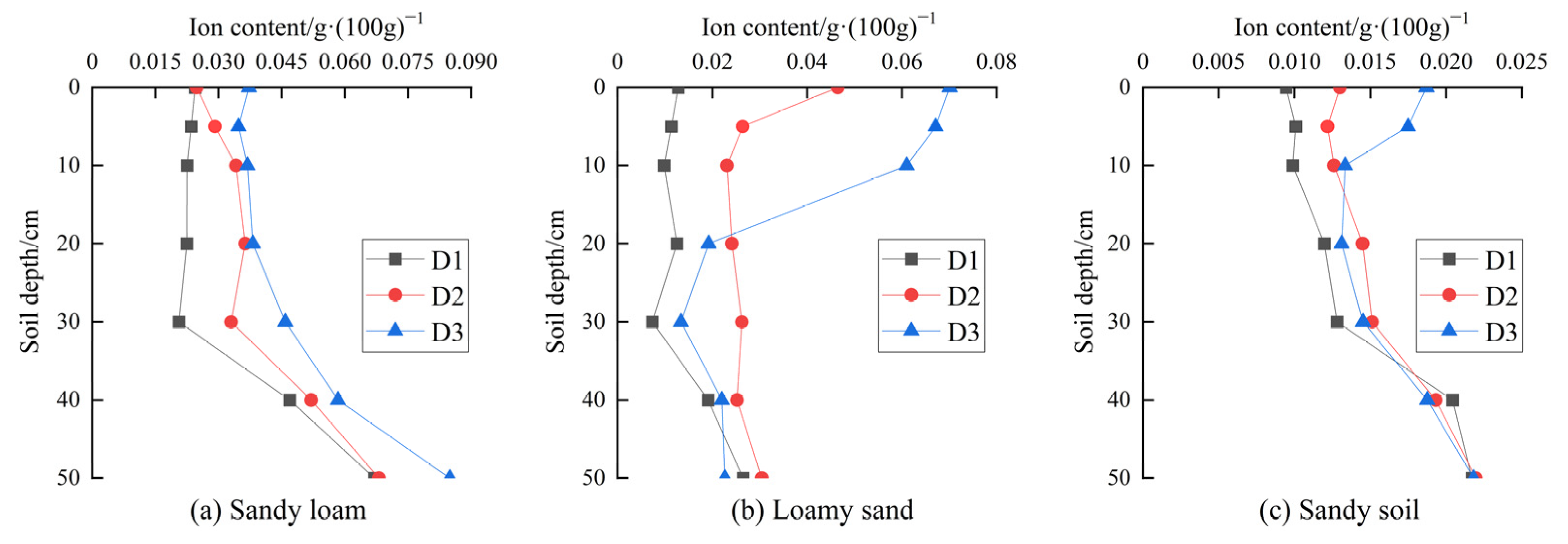
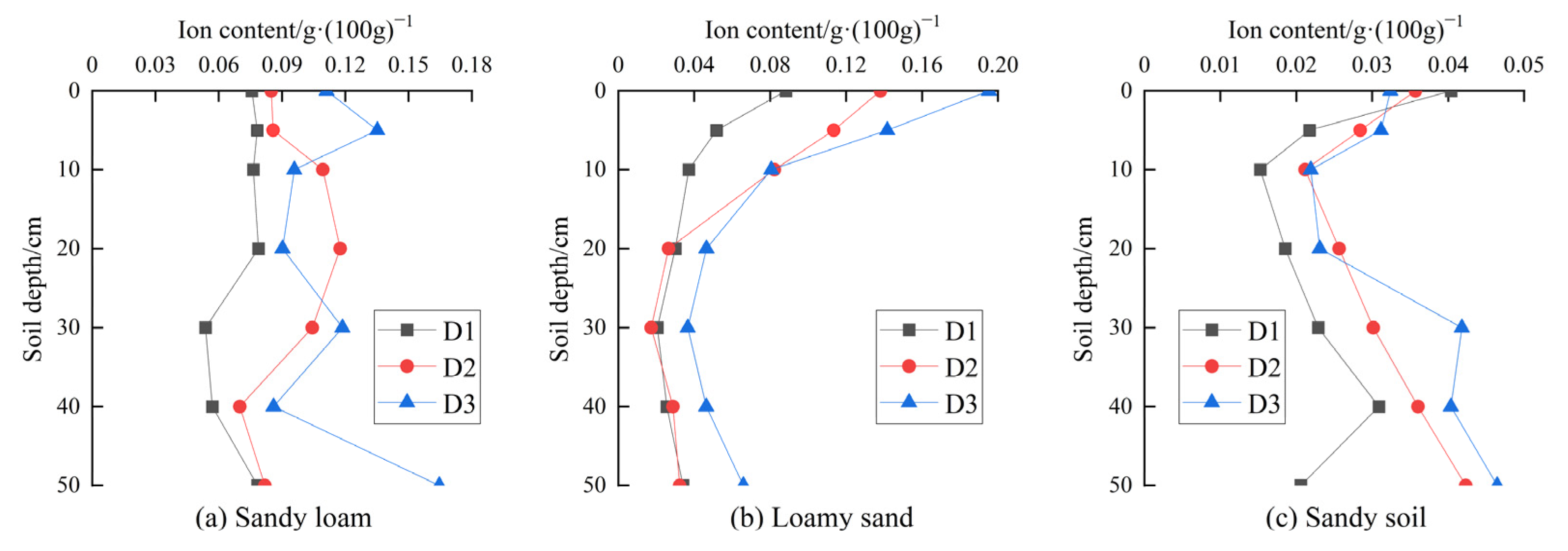

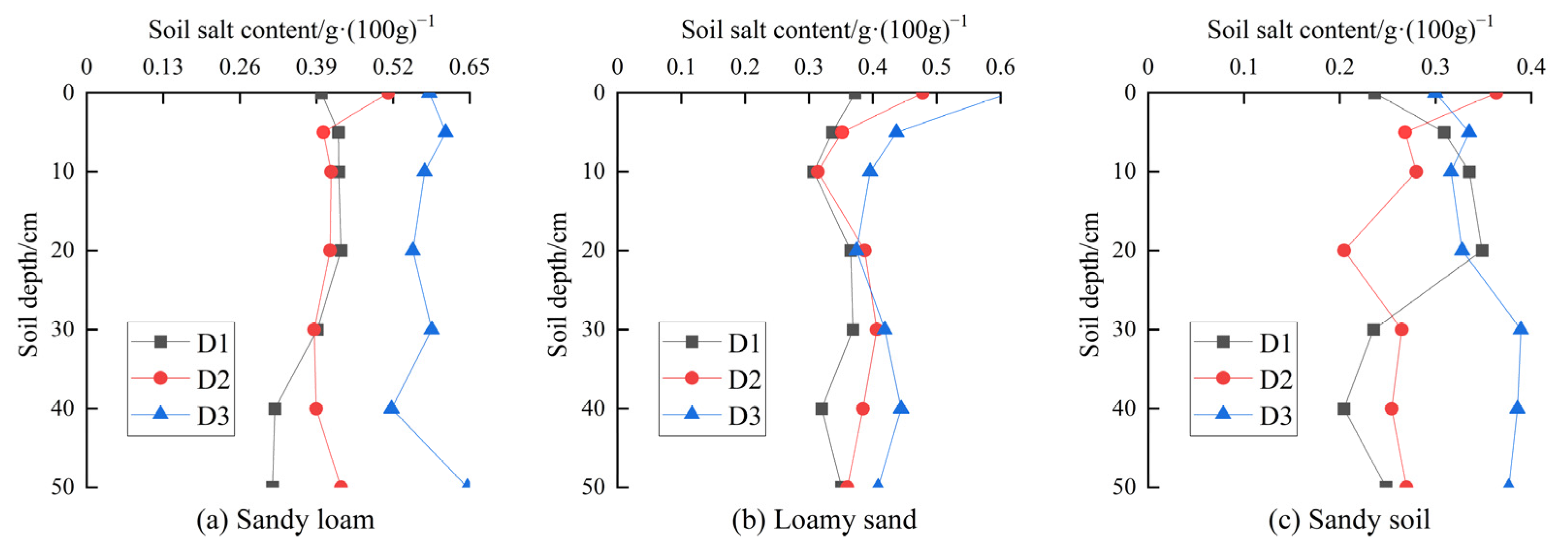
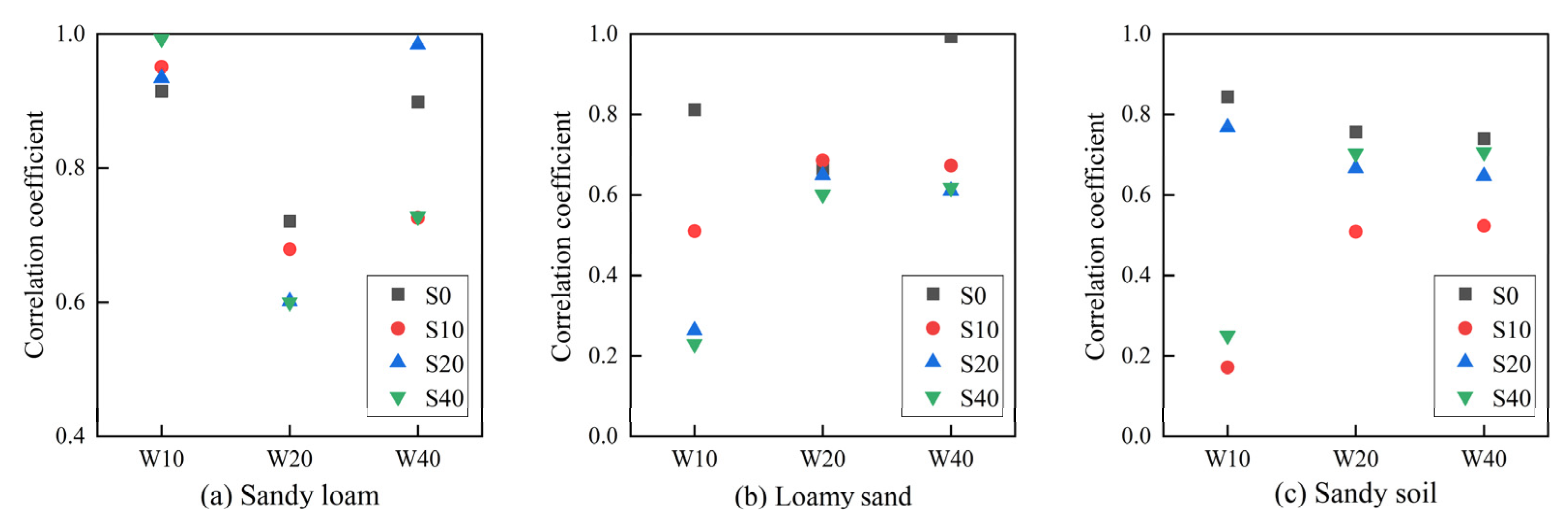
| Soil Texture | Mass Percentage of Different Textured Soils (%) | Maximum Capillary Height (cm) | Specific Yield (m3/m3) | Bulk Density (g·cm−3) | ||
|---|---|---|---|---|---|---|
| Clay | Silt | Sand | ||||
| Sandy Loam | 16.4 | 27.5 | 56.1 | 185 | 0.08 | 1.45 |
| Loamy Sand | 7.3 | 7.5 | 85.2 | 77 | 0.18 | 1.55 |
| Sandy Soil | 4.1 | 5.9 | 90 | 60 | 0.21 | 1.59 |
| Soil Freezing and Thawing Stage | Soil Texture | ||
|---|---|---|---|
| Sandy Loam | Loamy Sand | Sandy Soil | |
| Unstable Freezing Stage | From 18 November to 5 December 2020 | From 18 November to 3 December 2020 | From 18 November to 3 December 2020 |
| Stable Freezing Stage | From 6 December 2020 to 12 January 2021 | From 4 December 2020 to 9 January 2021 | From 4 December 2020 to 10 January 2021 |
| Thawing Stage | From 13 January to 13 February 2021 | From 10 January to 14 February 2021 | From 11 January to 15 February 2021 |
| Ionic Species | Soil Salt Content | Na+ | Ca2+ | Cl− | SO42− | HCO3− |
|---|---|---|---|---|---|---|
| Soil Salt Content | 1 | |||||
| Na+ | 0.9 | 1 | ||||
| Ca2+ | 0.817 | 0.694 | 1 | |||
| Cl− | 0.73 | 0.749 | 0.749 | 1 | ||
| SO42− | 0.806 | 0.798 | 0.833 | 0.847 | 1 | |
| HCO3− | 0.909 | 0.772 | 0.82 | 0.442 | 0.516 | 1 |
| Ionic Species | Soil Salt Content | Na+ | Ca2+ | Cl− | SO42− | HCO3− |
|---|---|---|---|---|---|---|
| Soil Salt Content | 1 | |||||
| Na+ | 0.99 | 1 | ||||
| Ca2+ | 0.694 | 0.591 | 1 | |||
| Cl− | 0.531 | 0.477 | 0.729 | 1 | ||
| SO42− | 0.873 | 0.872 | 0.616 | 0.49 | 1 | |
| HCO3− | 0.995 | 0.986 | 0.712 | 0.484 | 0.823 | 1 |
| Ionic Species | Soil Salt Content | Na+ | Ca2+ | Cl− | SO42− | HCO3− |
|---|---|---|---|---|---|---|
| Soil Salt Content | 1 | |||||
| Na+ | 0.99 | 1 | ||||
| Ca2+ | 0.608 | 0.493 | 1 | |||
| Cl− | 0.719 | 0.692 | 0.644 | 1 | ||
| SO42− | 0.874 | 0.884 | 0.752 | 0.659 | 1 | |
| HCO3− | 0.989 | 0.988 | 0.536 | 0.651 | 0.593 | 1 |
| Depth (cm) | Soil Water Content (%) | Soil Salt Content (g·(100 g)−1) | ||||
|---|---|---|---|---|---|---|
| Sandy Loam | Loamy Sand | Sandy Soil | Sandy Loam | Loamy Sand | Sandy Soil | |
| 0 | 0.004 | 0.020 | 0.094 | 0.184 | 0.242 | 0.063 |
| 5 | 0.119 | 0.143 | 0.199 | 0.182 | 0.100 | 0.026 |
| 10 | 0.058 | 0.083 | 0.173 | 0.146 | 0.088 | −0.019 |
| 20 | 0.006 | 0.086 | 0.120 | 0.122 | 0.009 | −0.021 |
| 30 | 0.018 | 0.035 | 0.058 | 0.195 | 0.050 | 0.154 |
| 40 | 0.048 | 0.009 | 0.012 | 0.198 | 0.124 | 0.181 |
| 50 | −0.016 | 0.010 | 0.004 | 0.330 | 0.057 | 0.128 |
Disclaimer/Publisher’s Note: The statements, opinions and data contained in all publications are solely those of the individual author(s) and contributor(s) and not of MDPI and/or the editor(s). MDPI and/or the editor(s) disclaim responsibility for any injury to people or property resulting from any ideas, methods, instructions or products referred to in the content. |
© 2023 by the authors. Licensee MDPI, Basel, Switzerland. This article is an open access article distributed under the terms and conditions of the Creative Commons Attribution (CC BY) license (https://creativecommons.org/licenses/by/4.0/).
Share and Cite
Wang, E.; Chen, J.; Liu, L.; Cui, L.; Xue, J.; Ren, J.; Du, Q. Effect of Soil Texture on Water and Salt Transport in Freeze—Thaw Soil in the Shallow Groundwater Area. Water 2023, 15, 2587. https://doi.org/10.3390/w15142587
Wang E, Chen J, Liu L, Cui L, Xue J, Ren J, Du Q. Effect of Soil Texture on Water and Salt Transport in Freeze—Thaw Soil in the Shallow Groundwater Area. Water. 2023; 15(14):2587. https://doi.org/10.3390/w15142587
Chicago/Turabian StyleWang, Erqing, Junfeng Chen, Lei Liu, Lihong Cui, Jing Xue, Jiameng Ren, and Qi Du. 2023. "Effect of Soil Texture on Water and Salt Transport in Freeze—Thaw Soil in the Shallow Groundwater Area" Water 15, no. 14: 2587. https://doi.org/10.3390/w15142587









